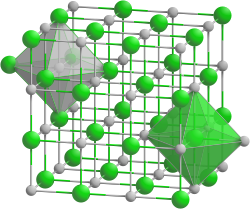Lithium bromide
| Crystal structure | |||||||||||||||||||
|---|---|---|---|---|---|---|---|---|---|---|---|---|---|---|---|---|---|---|---|

|
|||||||||||||||||||
| __ Li + __ Br - | |||||||||||||||||||
| Crystal system |
cubic |
||||||||||||||||||
| Space group |
Fm 3 m (No. 225) |
||||||||||||||||||
| Coordination numbers |
Li [6], Br [6] |
||||||||||||||||||
| General | |||||||||||||||||||
| Surname | Lithium bromide | ||||||||||||||||||
| Ratio formula | LiBr | ||||||||||||||||||
| Brief description |
bitter-tasting, colorless, hygroscopic solid |
||||||||||||||||||
| External identifiers / databases | |||||||||||||||||||
|
|||||||||||||||||||
| properties | |||||||||||||||||||
| Molar mass | 86.85 g mol −1 | ||||||||||||||||||
| Physical state |
firmly |
||||||||||||||||||
| density |
3.46 g cm −3 |
||||||||||||||||||
| Melting point |
550 ° C |
||||||||||||||||||
| boiling point |
1265 ° C |
||||||||||||||||||
| solubility |
|
||||||||||||||||||
| Refractive index |
1,783 |
||||||||||||||||||
| safety instructions | |||||||||||||||||||
|
|||||||||||||||||||
| Toxicological data | |||||||||||||||||||
| As far as possible and customary, SI units are used. Unless otherwise noted, the data given apply to standard conditions . Refractive index: Na-D line , 20 ° C | |||||||||||||||||||
Lithium bromide LiBr, the lithium salt of hydrobromic acid , forms colorless, highly hygroscopic crystals with a melting point of 550 ° C, a boiling point of 1265 ° C and a density of 3.46 g · cm −3 . The enthalpy of solution in water is −48.83 kJ / mol.
In addition to the anhydrous lithium bromide, there are also various hydrates , known are LiBr · n H 2 O with n = 1, 2, 3 and 5. The monohydrate LiBr · H 2 O has a density of 2.51 g · cm −3 .
Manufacturing
Lithium bromide is produced by reacting an aqueous lithium hydroxide or lithium carbonate solution with hydrogen bromide .
The lithium hypobromite formed in the reaction of elemental bromine with lithium hydroxide solution in addition to lithium bromide can be reduced to lithium bromide with formic acid or ammonia .
The anhydrous lithium bromide can also be produced by reacting lithium hydride with bromine .
properties
Lithium bromide is hygroscopic, concentrated solutions with 50% LiBr reduce the vapor pressure of the water by approx. 80%. It is very soluble in water ; 60% solutions can be prepared at 20 ° C. It is also readily soluble in ethanol and ethylene glycol . The solubility is low on the pressure, but strongly dependent on the temperature. Depending on the temperature, there are different hydrates of lithium bromide: below 4 ° C the trihydrate LiBr · 3 H 2 O, between 4 and 44 ° C the dihydrate LiBr · 2 H 2 O and between 44 and 159 ° C the monohydrate LiBr · H 2 O. The anhydrate is stable at even higher temperatures . The solubility diagram shows a kink at the transition point from monohydrate to anhydrate.
The standard enthalpy of formation of lithium bromide is ΔH f 0 = −351 kJ / mol.
use
- As a solution of lithium bromide in water for absorption refrigeration machines (> 50% of the lithium bromide produced).
- Because of its strongly hygroscopic effect as a drying agent, also for dehumidifying closed rooms.
- Organic syntheses. As a catalyst and educt .
- Flux when soldering.
- As an electrolyte in some types of lithium batteries.
- Until the 1950s as an anticonvulsant , sedative and agent against bipolar disorders (no longer in use due to severe side effects)
Individual evidence
- ↑ Entry on lithium bromide. In: Römpp Online . Georg Thieme Verlag, accessed on November 10, 2014.
- ↑ a b c d data sheet lithium bromide from AlfaAesar, accessed on February 5, 2010 ( PDF )(JavaScript required) .
- ↑ Dimethyl Sulfoxide (DMSO) Solubility Data. Gaylord Chemical Company, LLC; Bulletin 102, June 2014, p. 15. (PDF)
- ↑ David R. Lide (Ed.): CRC Handbook of Chemistry and Physics . 90th edition. (Internet version: 2010), CRC Press / Taylor and Francis, Boca Raton, FL, Index of Refraction of Inorganic Crystals, pp. 10-246.
- ↑ a b c Entry on lithium bromide in the GESTIS substance database of the IFA , accessed on February 1, 2016(JavaScript required) .
- ↑ Entry on lithium bromide at chemicalland21.com.
- ↑ Erich Meister: Basic practical course in physical chemistry. 2006, ISBN 3-8252-8329-1 .
- ^ Author collective: Organikum . 21st edition. Wiley-VCH, Weinheim 2001, ISBN 3-527-29985-8 , pp. 1151-1152.
- ↑ Herold, Keith; Radermacher, E .; Klein, Reinhard; Sanford, A .: Absorption Chillers and Heat Pumps. Boca Ration: CRC Press, 1996, ISBN 0-8493-9427-9 .
- ^ A b R. Abegg, F. Auerbach, I. Koppel: Handbook of inorganic chemistry. Verlag S. Hirzel, 1908, Volume 2, Part 1, pp. 128-129. Full text
- ^ AF Holleman , E. Wiberg , N. Wiberg : Textbook of Inorganic Chemistry . 101st edition. Walter de Gruyter, Berlin 1995, ISBN 3-11-012641-9 , p. 1170.
- ↑ Cold air air conditioning: cold generation below 0 ° C with a water / lithium bromide resorption chiller





